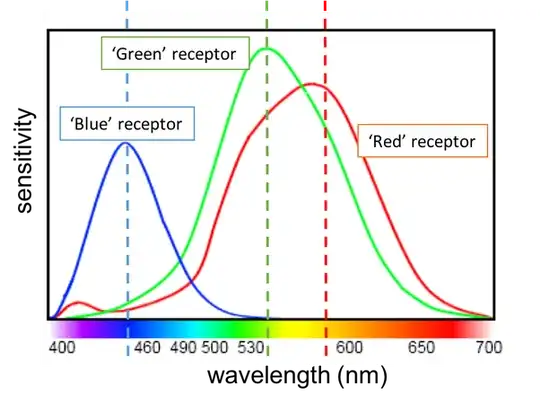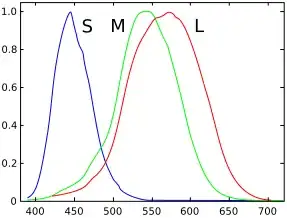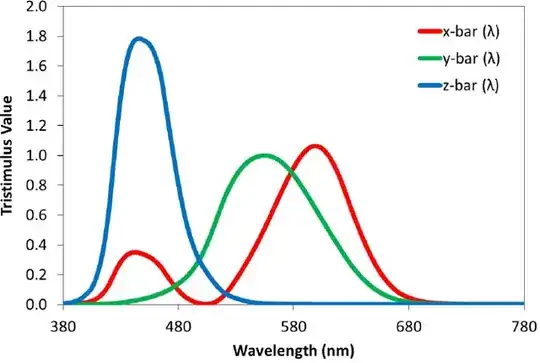The color receptors in your eyes are sensitive to a particular range of wavelengths. When you're seeing an object, this could generally be a complicated collection of different wavelengths. These are then detected by three kinds of cones (color receptors) and your brain then interprets this mess. The sensitivity of these cones look as follows:

What does this mean? If light with a wavelength of 600 nanometers hits your eye, your cones will detect a lot of red, some green and no blue. Your brain does some processing and then correctly interprets this as orange. The same holds true for every other wavelength in this range. This is quite impressive. Imagine someone hands you 3 numbers (how much light the red green and blue receptors detect) and you have to figure out what the original color is!
You can also trick your eyes. Instead of sending actual orange light, i.e. light with a wavelength of 600 nanometers, you can also send a combination of green and red light. If you pick the proportions right, you will see this as orange light as well. By picking a mix of the three basic colors of light, you can generate any color that your eyes can see.
What happens when you mix red and blue? When you mix red and green your brain interprets that as light having a wavelength that is between red and green: orange or yellow. Similarly, when you mix green and blue you get cyan. So, if you mix red and blue you should get green, right?? Well no, if you look at the left (short end) of the spectrum, you see there's a portion that's suddenly more sensitive to red. You're brain interprets this wavelength as purple/violet. If you mix blue and red, the brain thinks it is in the short part of the spectrum. If you add a lot of red, your brain will make up a color. It doesn't have to get the right wavelength, it just has to produce discernible colors. If you want to know how violet light looks like: I have a laser pointer of 405 nm and it looks like a grayish, mostly blue shade of purple.
So to answer your question: light on the short end of the spectrum looks purple and light on the long end of the spectrum looks red. If you mix the two, you get some shade of purple/magenta.
EDIT: So, the plot thickens. Thanks to the comments for pointing that out. The image I showed you is not the sensitivity of your actual light cones. That would look like this:

Based on Dicklyon's PNG version, itself based on data from Stockman, MacLeod & Johnson (1993) Journal of the Optical Society of America A, 10, 2491-2521d http://psy.ucsd.edu/~dmacleod/publications/61StockmanMacLeodJohnson1993.pdf
Here S, M and L stand for short, medium and long wavelengths. The plot I showed earlier represents the sensitivity in something that's called the XYZ color space. To get these values, a number of people were shown two colors: one monochromatic (single wavelength) color, and one mix of colors given by 3 predetermined colors. The participants were asked to match the monochromatic color by mixing those 3 colors. From a more reputable source I got the following image:

Blaszczak, Urszula & Zajac, Andrzej. (2016). SELECTED METROLOGY PROBLEMS IMPLIED BY THE APPLICATION OF LED TECHNOLOGY IN LIGHTING. Informatics, Control, Measurement in Economy and Environment Protection. 6. 6-11. 10.5604/20830157.1212257.
Note that the normalisations can vary a bit between sources.
More info on this observer can be found https://royalsocietypublishing.org/doi/epdf/10.1098/rsta.1932.0005 and https://en.wikipedia.org/wiki/CIE_1931_color_space#CIE_standard_observer.
So to summarize, when looking just at receptors, you get responses that are centered at a single wavelength (2nd image). When you include the processing that's done in your brain/optical nerves, you get a bump near blue (1st, 3rd image). This means that if you observe violet light, it elucidates the same response in your brain as if you see red and blue light together.


